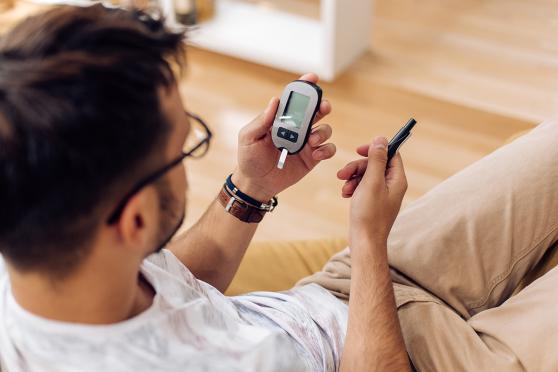Your 5-Step Diabetes Action Plan
These easy-to-follow tips can help you create a healthier lifestyle and more positive mindset after a diabetes diagnosis.

If you’ve just been diagnosed with diabetes, you might be feeling scared, upset, and overwhelmed. To help ease those feelings and find calm, take some time to learn about ways to get a handle on your diabetes. Knowing how lifestyle changes can make a difference is a great first step toward feeling better.
Follow this action plan from Maggie Powers, PhD. She’s a registered dietitian and a former president of health care and education at the American Diabetes Association.
Step 1: Breathe
“The first thing I say to newly diagnosed patients: ‘Take a deep breath and know there are people out there to help you,’” says Dr. Powers. If you feel overwhelmed, that can make it tough to take the next steps and manage your diabetes well.
“Diabetes is 99% self-management,” says Dr. Powers. However, you’ll likely have a care team to help you. That might include a certified diabetes expert (CDE), dietitian, and endocrinologist. But you’re with them only for a short amount of time during visits. So, it’s important to know how to manage your food and medication on your own. At the same time, don’t be afraid to call on the experts when you’re not sure what to do.
Need help managing the changes that come with a diabetes diagnosis? You have access to diabetes and stress-management programs through BlueForMe, your digital health navigator. BlueForMe connects you right to your care team. Call 844-730-2583 to see if you're eligible for BlueForMe today.
Step 2: Read the right materials
Before you start searching the internet for information and answers, make sure you’re looking at sources you can trust. A few to check out:
American Diabetes Association: You’ll find answers to top questions and helpful information on living with diabetes, diet and exercise advice, and the latest research. They also have information and support for caregivers.
Centers for Disease Control and Prevention: The CDC “Living with Diabetes” hub is packed with user-friendly strategies and tools. For example, the “Eat Well” page can help you with meal planning, counting carbs, and eating out. And “Your Diabetes Care Schedule” can help you stay on track with your self-checks and doctor appointments.
Step 3: Get help with your meals
Sit down with your CDE or dietitian to talk about your daily diet. Ask about how your favorite foods can fit into your meal plan. Dr. Powers says she usually starts by looking at food diaries with her patients. Then they talk in more detail about what the patient is eating. They cover topics such as:
- Serving size.
- How foods are being made.
- Meal timing.
- Beverages.
“We often teach carbohydrate counting as part of the initial food plan. This shows patients how carbohydrates fit into a diabetes eating plan,” says Dr. Powers. “I want people to leave feeling confident making food decisions.”
Did you know you can sync your glucometer with your BlueForMe app to send real-time blood sugar readings to your care team? Call 844-730-2583 to see if you're eligible for BlueForMe today.
Step 4: Be more active
When you’re newly diagnosed, your doctor and diabetes team may suggest you balance your food and medication first and then add exercise. Once your doctor has given the okay, aim for 150 minutes of moderate-intensity aerobic exercise each week. Some examples: brisk walking, doing housework, or dancing.
If 150 minutes sounds like a lot, try dividing the time into chunks. That can help make the goal more doable. For example, do 30 minutes of exercise 5 days a week. Or spread it out a little more and do 25 minutes of exercise 6 days a week.
If walking is your choice of exercise, you might want to start wearing a pedometer or step counter. This will help you see about how many steps you take in a day. Then work your way up to about 8,000 steps a day. A recent study found that to be the target goal for increasing longevity.
If possible, try not to go more than 2 days a week without exercising. “Make sure to talk to your physician about how to exercise safely with diabetes as well as your short-term and long-term goals,” says Dr. Powers. Add strength training and balancing exercises to your weekly workouts, too. The ADA offers suggested exercise plans to get you started.
Step 5: Get support
You don’t have to learn how to live with diabetes all on your own — and you shouldn’t. Think of it as a group effort with your doctor and the people you trust in your community. Start by connecting with the right experts.
For example, a diabetes educator can help you with your insulin routine. They can answer questions about injection sites and timing. Feeling stressed or anxious about your diagnosis? A mental health practitioner can listen and share ways to cope better. Or look for a diabetes support group in your area. “Group classes are fun. And other people often raise questions you’re thinking of asking,” says Dr. Powers.
You can also ask your doctor for the referrals you need. Or log in to your BlueForMe app on your smartphone to connect with your diabetes care management team. From there, your team can help you with referrals. Plus, they can work with you directly on a diabetes management program and connect you with other resources.
Finally, don’t forget to lean on loved ones for support. Family support has been shown to help patients with type 2 diabetes achieve better health results. Try bringing your partner to your doctor’s appointment. Or take your family food shopping to teach them what you’re looking for on food labels.
“There’s a lot of hope to have about your diabetes diagnosis if you get the right team around you,” says Dr. Powers. “You have to take your diagnosis seriously. But you should feel confident you can live well with diabetes and have it fit your lifestyle.”
If you need help navigating your healthcare, one of the fastest ways is through BlueForMe, your digital health advocate. Call 844-730-2583 to see if you're eligible for BlueForMe today.
[SOURCES:]
“Diabetes: Get Active.” Centers for Disease Control and Prevention, www.cdc.gov/diabetes/managing/active.html. Accessed July 15, 2021.
Pamungkas RA, Chamroonsawasdi K, Vatanasomboon P. “A Systematic Review: Family Support Integrated with Diabetes Self-Management among Uncontrolled Type II Diabetes Mellitus Patients.” Behavioral Sciences, vol 7, no. 3, 2017, pp: 62.
Saint-Maurice PF, Troiano RP, Bassett DR, et al. “Association of Daily Step Count and Step Intensity with Mortality Among US Adults.” JAMA, vol. 323, no. 12, 2020, pp: 1151-1160.
DISCLAIMER: Florida Blue has entered into an arrangement with Wellframe to provide members with care decision support services, information and other services. This article is provided by Linkwell Health through their arrangement with Wellframe. Please remember that all decisions that require or pertain to independent professional medical/clinical judgment or training, or the need for medical services, are solely your responsibility and the responsibility of your physicians and other healthcare providers. Wellframe is an independent company that provides online services to Florida Blue members through the Blue for Me app.



